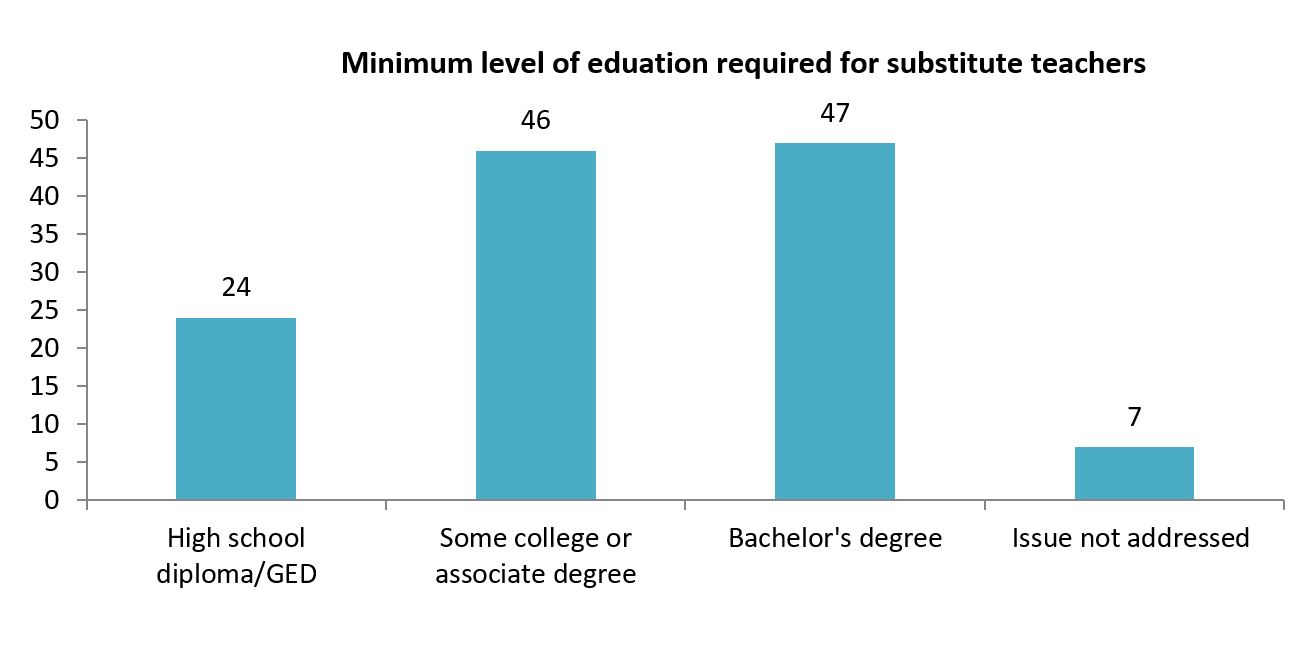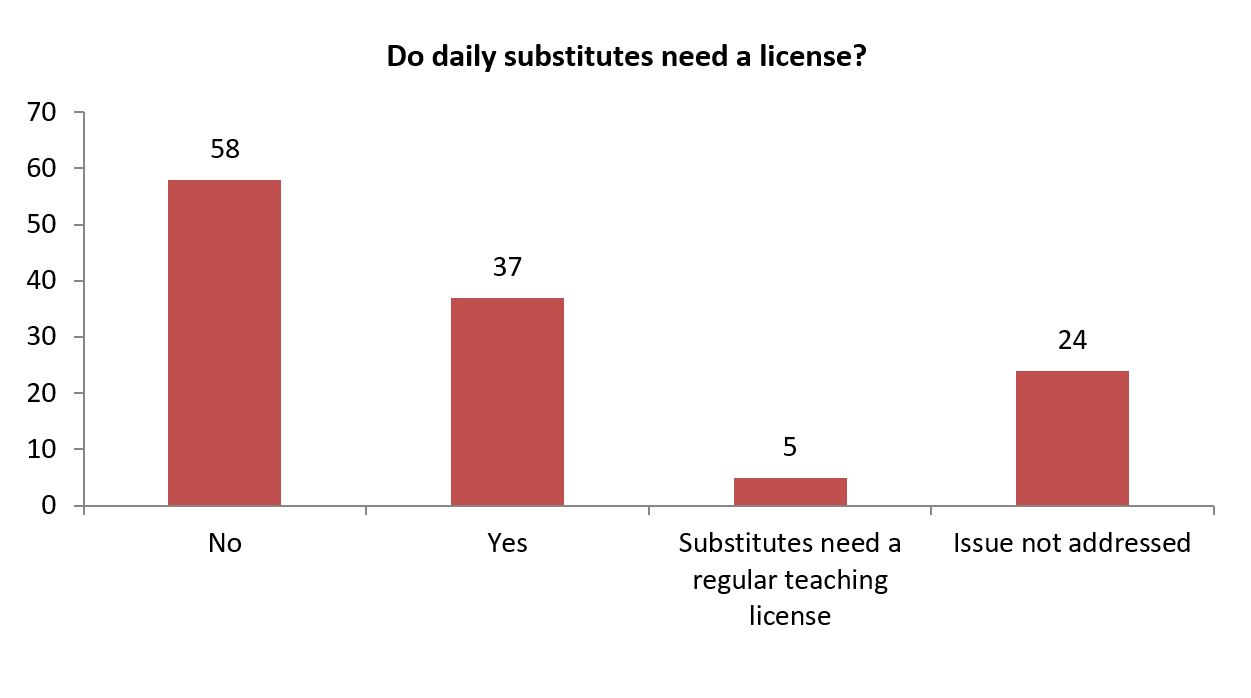District Trendline, previously known as Teacher Trendline, provides actionable research to improve district personnel policies that will strengthen the teacher workforce. Want evidence-based guidance on policies and practices that will enhance your ability to recruit, develop, and retain great teachers delivered right to your inbox each month? Subscribe here.
As students around the country return to class, far too many will find a substitute teacher at the helm. This situation is the result of many districts being unable to fill all their teaching positions, particularly in hard-to-staff schools and subjects. Having a substitute teacher almost invariably means students will lose ground—and even lose out on seeing some rare celestial events.
Not only are districts struggling to find some teachers, they can’t even find enough substitutes. Districts try to mitigate learning loss under substitutes by setting baseline qualifications for substitutes but are they shooting themselves in the foot?
Here we take a look at districts’ qualifications for their substitutes as well as their compensation.
Substitute requirements (education, licensure, and evaluation)
Education
While all districts require regular teachers to have at least a bachelor’s degree, their education requirements for substitutes vary widely. Of the 124 districts we track here, the majority require substitutes to have some level of postsecondary education, but only about a third (38 percent) require a bachelor’s degree.

Many districts set higher educational standards for substitute teachers than their states require, and, as a result, district requirements for subs are generally more stringent than those at the state level. Thirteen states require subs to have only a high school education, and 16 do not specify any requirement. Of the 92 districts we track in these states, just over two-thirds require at least some higher education.
Digging down into this with an example, Texas is one of the states that has no articulated education requirement for substitutes. Of the 21 Texas districts we track, all but two require more than a high school education. In fact, five require bachelor’s degrees (Cypress-Fairbanks Independent School District, Frisco ISD, Garland ISD, North East ISD, and Plano ISD).
Distinguishing between daily and long-term substitutes
In some cases, having the minimum level of education required by the district only allows a substitute to teach for a limited number of days or in specific situations, whereas long-term substitutes need a higher level of education or even a teaching degree. For example, a substitute in Cobb County School District (GA) with a high school diploma or GED can only teach for 10 consecutive days but needs a bachelor’s degree beyond the 10th day. A high school diploma or GED enables a substitute in Seminole County Public Schools (FL) to work for a limited number of days, but the district requires that a substitute working 30 school days or longer be eligible for a Florida teaching certificate or have a bachelor’s degree or higher in the subject. In Albuquerque Public Schools, a substitute with a high school education can only work at one school site and for no more than 5 consecutive days; to work more, the district requires an associate degree or 60 hours of college coursework.
Licensure
While the most common district policy is not to require any type of certification or license to become a substitute teacher, about a third do require some type of license from the state. In fact, five require substitute teachers to have the same teaching license as any teacher (Cherry Creek School District (CO), Kanawha County Schools (WV), San Diego Unified School District, Portland Public Schools (OR), and Seattle Public Schools). The remaining districts that require a license have a separate substitute license, the requirements of which vary greatly from state to state and district to district.

As with education levels, some districts that do not require any kind of licensure or permit for daily substitutes set a higher bar for their long-term substitute teachers. Anchorage School District does not require a license for daily substitutes, but substitutes working for longer than 20 days need an Alaska teaching certificate. Even if no license is required, districts often impose a process such as in Hillsborough County Public Schools (FL), where substitute teachers must complete a training program, and in Wake County School District (NC), where substitutes need to first pass a test.
Evaluation
Approximately two thirds of our 124 districts do not explicitly address evaluation for daily substitutes, which likely means that they do not evaluate them. Only 15 districts indicate that all their substitutes must be evaluated and 23 reserve the right to evaluate, usually at the discretion of the principal or when performance is a concern.
Compensation
The daily rate of pay for substitutes varies dramatically across districts, although our numbers here do not take into account cost of living. For example, Chesterfield County Public Schools (VA) offers the lowest minimum daily rate of $49, or just over $6 an hour for an 8 hour workday, and Boston Public Schools pay substitutes up to $284 per day, which comes out to over $35 an hour.

When looking at substitute pay across the country, three factors emerge as the primary determinants of how much a sub will be paid:
1. Number of days worked
2. Certification or licensure status
3. Educational attainment
Related to education and licensure, some districts have a special pay rate for retired teachers – a practice that can help expand the substitute pool with qualified candidates. Almost 44 percent of districts use two or more of the factors in the graph below, and Jordan School District (UT) uses all four.

Primary factors in compensation
The factor that influences pay in the most districts is the number of days a sub works, often having one rate for the first several days and another for a long-term assignment. Typically, this applies to consecutive days worked or consecutive days in the same position, but Washoe County Public Schools (NV) and San Francisco Unified School District increase pay based on the total number of daily assignments, with San Francisco providing a higher rate for a long-term assignment as well.
In general, credentials also matter for substitute pay, and candidates that seem more qualified on paper often earn more. Districts that do not require a substitute license often pay more to substitutes who have one, and districts that do require such a license may also pay a higher rate to subs who have the credentials required of a full time teacher.
As with licensure, substitutes who have a higher level of education than the district requires will often command a higher daily rate than their less educated peers in that same district. In addition to the relationship between education level and pay within district, we see evidence of a relationship between education and pay across districts, although this does not hold true for each and every one of our 124 districts. For districts that mandate that substitute teachers have a bachelor’s degree, the average minimum and maximum daily rates are $103 and $142, respectively. In districts with lesser education requirements, the average minimum daily rate is $85 and the average maximum daily rate is $121.
Additional factors in compensation
Interestingly, some districts use other more rare factors to entice substitutes to work when and where they are needed most. These factors include additional pay for working on Fridays, such as in Dallas Independent School District and Austin Independent School District, working at a particular type of school, like in Clark County School District (NV) and Knox County Schools (TN), or working and being certified in a critical shortage area, as in Baltimore County Public Schools. Two districts, Jefferson County Public Schools (KY) and Providence Public School District, partially base compensation on the number of years the substitute has been employed in the district – a system that potentially helps their substitute retention.
Together, the factors discussed above can make the rate of pay vary widely within districts. In fact, in six districts, the difference between the highest and lowest daily rates is $100 or more. Chesterfield County Public Schools (VA) has the greatest variation. Substitutes without a college degree who work for less than 20 days make $49 per day, and that amount quadruples to $197 for subs who have a bachelor’s degree and work for 20 or more days.
To learn about the qualifications, evaluations, and compensation of substitute teachers in large districts around the country, visit the Teacher Contract Database.
The Teacher Contract Database includes information on 147 school districts and 2 charter management organizations in the United States including: the 100 largest districts in the country, the largest district in each state, and the member districts of the Council of Great City Schools. The database features answers to over 100 policy questions and provides access to teacher contracts, salary schedules, and board policies in addition to relevant state laws governing teachers.
[1] The maximum rate reflects the highest daily rate a substitute could receive in each district given optimal circumstances (the highest level of education, correct licensure, working multiple days, as well as working on particular days of the week or in certain schools, etc.)
[2] For districts that have an hourly rate, NCTQ assumed an eight-hour workday.
[3] In Bismarck Public Schools, substitutes who serve more than 11 days are paid at the same rate as teachers on the BA-0 schedule. NCTQ divided this yearly salary by the 187 days in Bismarck’s contracted school year to get the daily rate.
[4] In addition to a higher rate for long-term substitutes, substitute teachers in Montgomery County Public Schools (MD) can receive a lump sum bonus of up to $450 at the end of the semester based on total days worked. This lump sum is not included in the maximum daily rate calculation.

